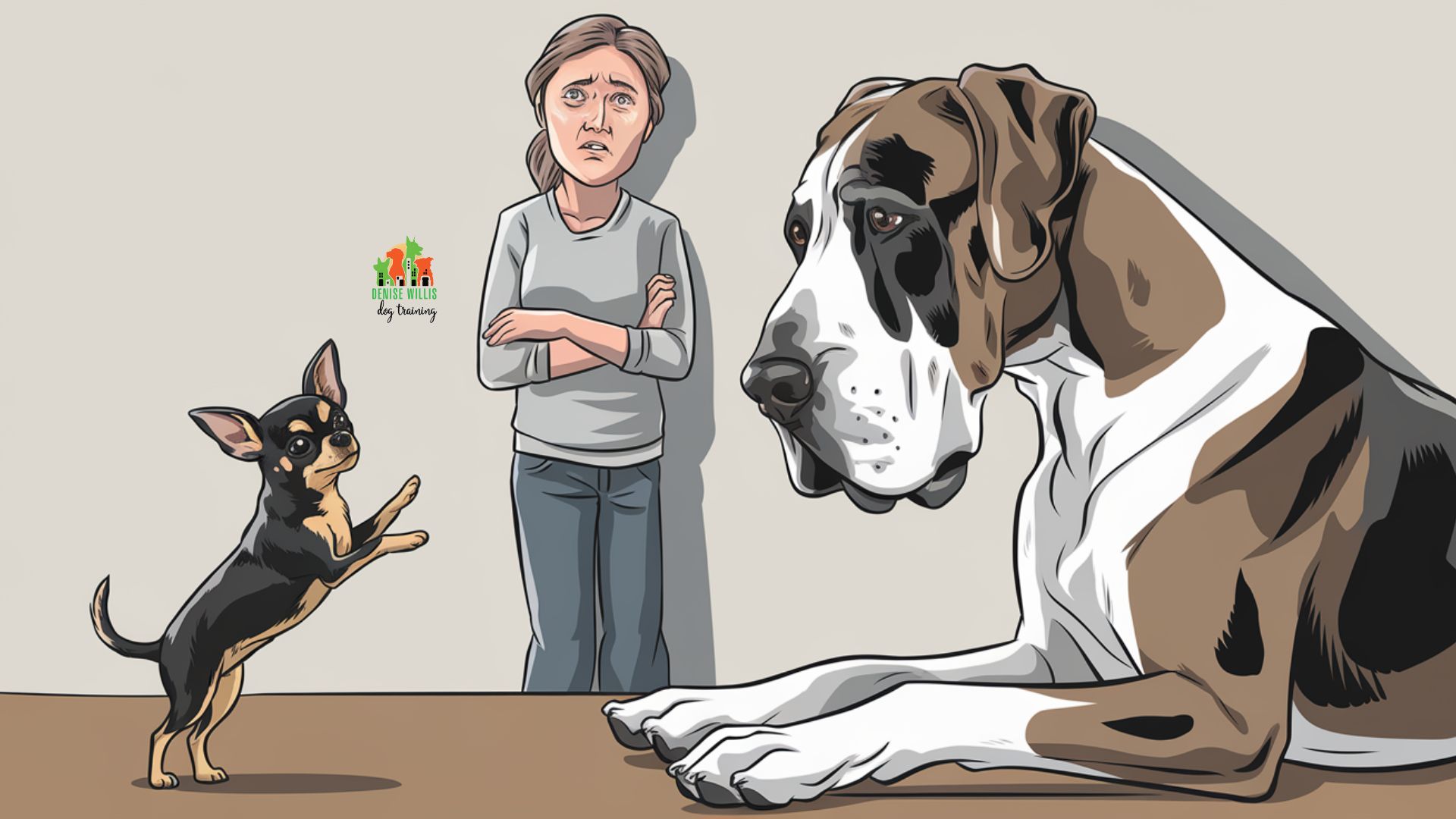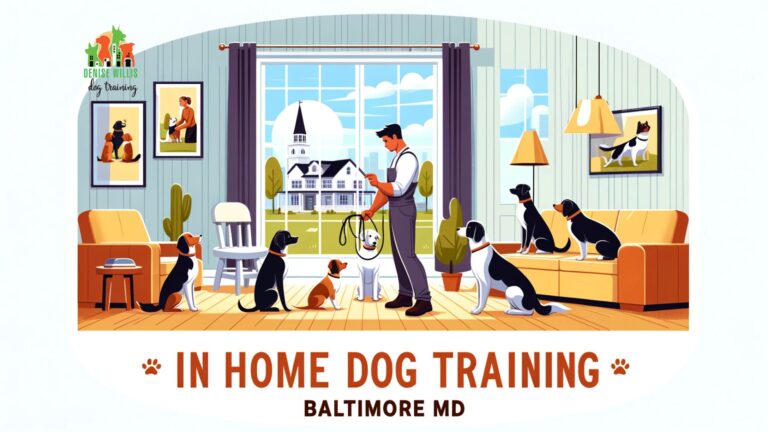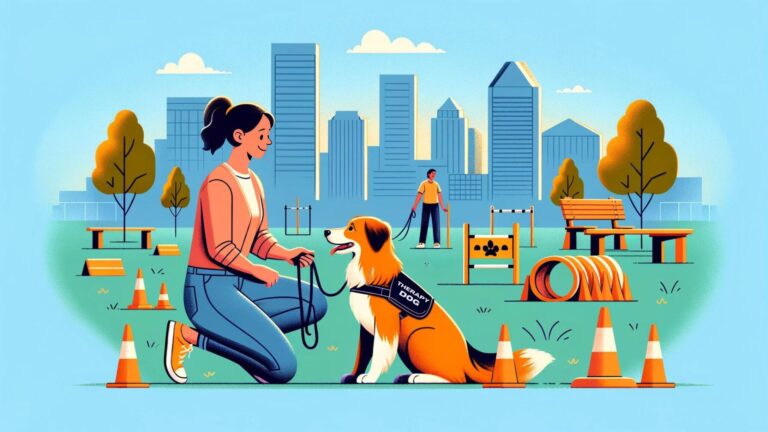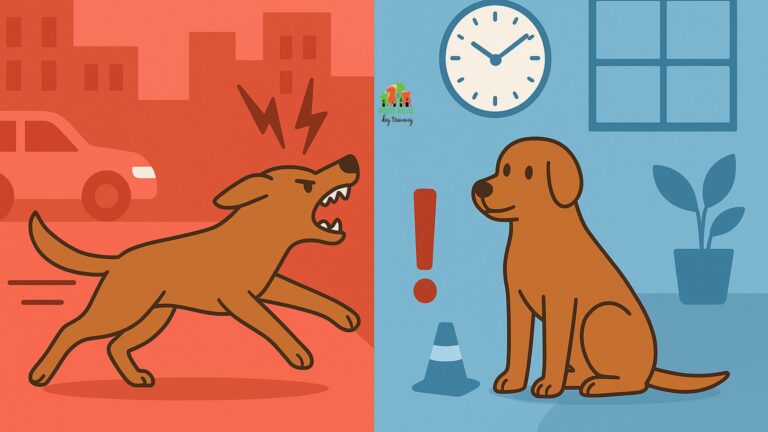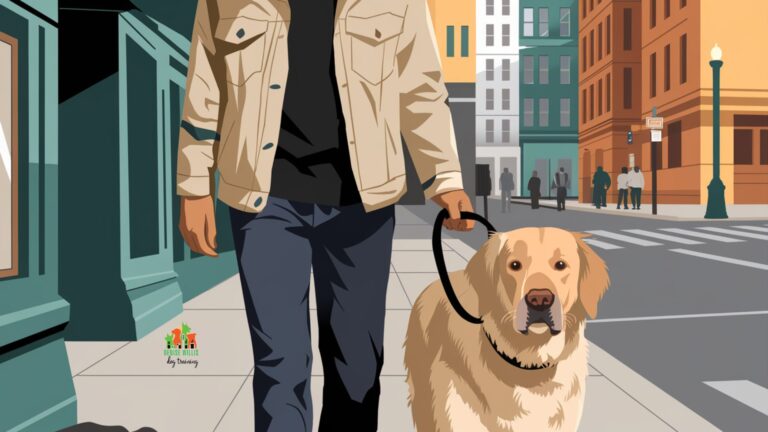Breed-Smart Training: Tailored Approaches to Managing Dog Aggression
📍 Service Area Notice: DW Dog Training provides in-person training services exclusively in the Greater Baltimore area. While our blog content is designed to help dog owners internationally, our hands-on training services are locally focused. For readers outside our service area, we hope you find value in our articles and welcome you to reach out with questions!
Ever watched a Chihuahua square up to a Great Dane like they’re auditioning for a tiny boxing championship?
While it might seem amusing, breed-specific dog aggression is no laughing matter – though we can definitely appreciate the irony of a four-pound warrior challenging the canine equivalent of a small horse.
Understanding aggression isn’t as simple as labeling a dog “good” or “bad.” Research has identified seven distinct types of aggression, each with its own triggers and solutions. It’s like having seven different personality quirks rolled into one furry package – except these quirks need more than just a belly rub to resolve.
Think of breed-specific dog aggression management like tailoring a suit.
You wouldn’t put a Great Dane in a Chihuahua-sized sweater (though the mental image is priceless), so why would we use a one-size-fits-all approach to aggression training?
Breed-Smart Training at a Glance
Before we dive deeper than a retriever after a tennis ball, let’s fetch the essential points of breed-smart training. Think of this as your cheat sheet for when your dog decides to act like they’ve never heard of basic manners (we’re looking at you, adolescent Lab who suddenly forgot “sit” exists).
Breed-Smart Training: Your Guide to Canine Peace Talks
Know Your Breed
Like understanding why your Border Collie reorganized your sock drawer – some breeds just have specific “features” (not bugs). Learn your breed’s quirks to prevent surprises!
Warning Signs
Your dog’s giving you more signals than a traffic light convention. Learn to read the signs before your pup’s “conversation” turns into a bark-fest.
Training Tools
From harnesses that turn your puller into a polite pedestrian to treats that make training feel like a game show – pick the right tools for your breed.
Prevention Power
Like avoiding the dog park during the local Chihuahua fight club meeting – smart management prevents 90% of problems before they start!
There you have it.
Your quick guide to preventing your peaceful neighborhood walk from turning into an impromptu audition for “Dogs Gone Wild.” Remember, these aren’t just fancy graphics. They’re your roadmap to understanding why your German Shepherd thinks the mailman is plotting world domination.
Key Takeaways
Before we dive deeper than a retriever after a tennis ball, let’s fetch some essential points:
- Safety First, Instagram-worthy Moments Second: The ASPCA emphasizes that understanding breed-specific traits is crucial for effective management – it’s not about discrimination, it’s about smart training.
- Every Breed Has Its Quirks: Just like how humans have different personalities (and coffee preferences), different breeds come with their own special behavioral source code.
- Professional Guidance Matters: Sometimes, Google University isn’t enough. Professional training can be the difference between “Who’s a good boy?” and “Who destroyed the couch?”
Understanding Breed-Specific Aggression
When it comes to understanding why your furry friend might be channeling their inner Cujo, it’s essential to recognize that aggressive behavior isn’t a one-size-fits-all problem. Just like how some people can’t function without their morning coffee while others bounce out of bed ready to conquer the world, different breeds come with their own unique behavioral blueprints that influence how they react to stress, excitement, or that suspiciously moving leaf in the backyard.
Genetic Predispositions: More Than Just DNA Drama
While breed alone doesn’t determine aggression, certain genetic predispositions can influence behavioral tendencies. It’s like how some people are born to be marathon runners, while others excel at competitive napping – genes play a role, but they’re not the whole story.
Consider this: Border Collies weren’t born with an innate desire to organize your sock drawer. Their herding instincts come from generations of breeding for specific purposes. These inherited traits can manifest in various ways, from the notorious nipping behavior of herding breeds to the protective nature of guardian breeds.
Let me think through this step-by-step:
- This statistic section would have the most impact after introducing breed-specific aggression but before diving into training approaches, likely following the “Understanding Breed-Specific Aggression” section.
- The heading and content should match the established tone while maintaining informative value.
- The intro needs to bridge from theoretical concepts to hard data in an engaging way.
- The outro should transition smoothly into training approaches while acknowledging the complexity of the data.
Here’s the section I recommend:
The Numbers Behind the Barks: What Statistics Tell Us
Remember that time you tried convincing someone that your Chihuahua’s Napoleon complex was “just a phase”? Well, grab your reading glasses and perhaps a calming cup of tea – we’re about to dive into some numbers that might make your tiny warrior’s attitude look like amateur hour.
While statistics can be about as exciting as watching paint dry (or in dog terms, watching your Lab stare at a wall for no apparent reason), these numbers tell a fascinating story about breed-specific aggression. They’re like your dog’s report card – if report cards included bite statistics and insurance claims.
| Category | Statistic | Details | Source |
|---|---|---|---|
| High Aggression Breeds (Dog-Directed) | 20%+ | Akitas, Jack Russell Terriers, and Pit Bull Terriers showed serious aggression toward unfamiliar dogs | [1] |
| Fatal Attacks (Pit Bulls) | 185 deaths | Highest number of fatal incidents among all breeds (2010-2021) | [3] |
| Fatal Attacks (Rottweilers) | 26 deaths | Third highest number of fatal incidents (2010-2021) | [3] |
| Insurance Claims (California) | 1,954 claims | Highest number of dog bite insurance claims by state (2019) | [3] |
| Low Aggression Breeds | 6 breeds | Golden Retrievers, Labrador Retrievers, Bernese Mountain Dogs, Brittany Spaniels, Greyhounds, and Whippets showed lowest aggression rates | [1] |
| Breed-Specific Legislation Opposition | 71% | Percentage of survey respondents opposed to breed-specific legislation | [8] |
Before you start panic-googling how to rehome your beloved breed that just made the “spicy personality” list, remember these numbers are like your GPS giving you a heads-up about potential traffic – they’re guides, not guarantees. Just as knowing Chicago has the most pizza places doesn’t mean you’ll definitely find good pizza there (though let’s be honest, you probably will), these statistics help us understand patterns without defining individual dogs.
Would you like me to refine any part of this section or adjust its placement in the article?
Common Triggers by Breed Groups
Understanding breed-specific triggers is like having a cheat sheet for your dog’s behavior. While every dog is unique (just ask any proud pet parent who’s convinced their fur baby is actually a misunderstood genius), certain patterns emerge when we look at different breed groups.
Think of it as your dog’s ancestral programming. Sometimes it needs a little debugging for modern life.
Working Breeds: The Overachievers
Working breeds are like that colleague who sends emails at 3 AM – they need a job, or they’ll make one up. Without proper outlets, these high-drive dogs might channel their energy into less desirable behaviors.
Guardian Breeds: The Security System Upgrade
Rottweilers, German Shepherds, and similar breeds take their home security duties as seriously as a mall cop with a new Segway. While their protective instincts can be invaluable, they sometimes need a gentle reminder that the Amazon delivery person isn’t plotting world domination.
Herding Breeds: The Micro-Managers
These four-legged supervisors were bred to keep sheep in line, but now they’ve promoted themselves to CEO of Everything That Moves. That nipping behavior isn’t aggression – it’s their way of filing a motion for everyone to stay in formation. Unfortunately, most houseguests don’t appreciate being herded to the dinner table.
Training Approaches and Tools
Think of managing breed-specific aggression like cooking. You need the right ingredients, proper tools, and sometimes, a willingness to order takeout (aka professional help) when things get too spicy.
Professional Evaluation Process
Just like you wouldn’t diagnose yourself using WebMD (we’ve all been there, convinced that headache was something exotic), professional evaluation is crucial for understanding your dog’s specific challenges. A good trainer doesn’t just look at the behavior – they investigate the whole story, from past experiences to current triggers, like a canine detective minus the deerstalker hat.
Assessment Protocols That Actually Work
The evaluation process isn’t just about checking boxes (though we do love a good checklist). It’s about understanding your dog’s unique “operating system” and why they sometimes go into blue screen mode when seeing another dog across the street.
Risk Assessment Steps
When it comes to evaluating your dog’s spicy behavior moments, professionals don’t just wing it like your cousin trying to make grandma’s secret recipe. They follow a structured approach that’s more organized than Marie Kondo’s sock drawer.
The process involves careful observation of triggers, body language analysis, and threshold testing – all designed to create a tailored rehabilitation program that actually sticks. It’s like creating a personalized Netflix algorithm for your dog’s behavior, minus the “Are you still watching?” shame.
Multi-Dog Households
Living with multiple dogs can feel like managing a furry version of Real Housewives – complete with drama, alliances, and occasional table-flipping incidents. Let’s break down how to maintain peace in your canine council.
Pack Dynamics: Not Just a Wolf Thing
Managing multiple dogs requires understanding that modern pack dynamics are less about dominance and more about resource distribution and clear communication. Think of it like a shared apartment. Everyone needs to know the house rules, respect personal space, and agree that the good spot on the couch is communal property.
Exercise and Mental Stimulation
Breed-Specific Requirements
Your Border Collie and your neighbor’s Bulldog have about as much in common exercise-wise as a caffeinated squirrel and a sleepy sloth. Let’s break down what different breeds actually need to stay mentally and physically balanced.
High-Energy Breeds: The Marathon Runners
These dogs approach exercise like it’s their full-time job, complete with overtime and weekend shifts. Without proper outlets, they’ll redesign your living room into an obstacle course – usually featuring your favorite throw pillows as hurdles.
Working Breeds: The Professional Athletes
These overachievers need more than just physical exercise – they require mental challenges that make solving a Rubik’s cube look like a warm-up. Think advanced training sessions, problem-solving games, and activities that make them feel like they’ve earned their kibble.
Veterinary Collaboration
Just like how you shouldn’t diagnose yourself through social media medical memes, your dog’s behavioral issues might need professional medical insight.
Sometimes what looks like aggression is actually your pup’s way of saying, “Hey, something doesn’t feel right!”
Medical Considerations
Veterinary professionals play a crucial role in distinguishing between behavioral issues and medical conditions that might manifest as aggression. It’s like having a translator for your dog’s internal “check engine” light.
Health-Related Aggression Factors
Pain, thyroid issues, or neurological conditions can turn your usually sweet pup into a grumpy gremlin faster than you can say “vet appointment.” Sometimes, what looks like a training issue is actually a medical plot twist waiting to be discovered.
Prevention and Early Intervention
The best time to plant a tree was 20 years ago.
The best time to start prevention training? Yesterday.
But today works too.
Socialization: Your Pup’s Social Media Strategy
Early socialization isn’t just about making your puppy Instagram-famous at the dog park. It’s about creating positive associations during critical developmental periods. Think of it as building your dog’s emotional immune system – the more positive experiences they bank early on, the better equipped they’ll be to handle life’s curveballs.
Critical Periods: Timing is Everything
Remember being a teenager and everything feeling like the end of the world? Puppies go through similar dramatic phases, except instead of questionable fashion choices, their experiences shape lifelong behaviors. The first 16 weeks of a puppy’s life are like their own personal Netflix series – every episode matters for character development.
Risk Mitigation: Your Dog’s Personal Safety Net
Think of socialization like building your dog’s emotional savings account. The more positive experiences you deposit early on, the better equipped they’ll be to handle those unexpected behavioral withdrawals later in life.
Success Maintenance
Maintaining behavioral improvements is like keeping up with your New Year’s resolutions – it takes more than just good intentions and treats. Let’s break down how to keep your training wins from becoming temporary victories.
Long-term Strategies
Remember that time you learned a TikTok dance and immediately forgot it? Training can be like that – except with more serious consequences than social media embarrassment.
Consistency is Key (But Not Boring)
Training maintenance doesn’t mean doing the same thing until you both die of boredom. It’s about creating sustainable routines that evolve with your dog’s progress. Think of it as updating your dog’s behavioral software. Regular patches are required.
Product Recommendations
Ready to level up your breed-specific training game?
While a magic wand for instant dog behavior transformation hasn’t hit Amazon yet (we’re still waiting!), we’ve rounded up some gear that’s the next best thing. Think of these as your Swiss Army knife for handling those “interesting” moments when your dog decides the neighbor’s cat is actually a tiny ninja in disguise.
- PetSafe Deluxe Easy Walk Harness: Transform your canine powerhouse into a polite pedestrian with this engineering marvel. It’s like power steering for your dog, redirecting their forward momentum without the neck strain. Warning: Your formerly pulling pooch might get so well-behaved that other dog owners accuse you of hiring a stunt double.
- HALTI Head Collar: The ultimate “gentle leader” for dogs who think they’re secretly sled dogs. Provides control without force, like having a volume knob for your dog’s enthusiasm. Caution: Your dog may temporarily believe they’ve joined a secret society of sophisticated canines who wear face accessories.
- Pet Convincer Pro: A training tool that uses compressed air to interrupt unwanted behaviors. Think of it as a reset button for your dog’s “moment of drama.” Warning: May cause your dog to reconsider their career as a professional barker at invisible threats.
- KONG Extreme Dog Toy: The indestructible fortress of solitude for power chewers. Stuff it with treats, and suddenly your guard dog becomes more interested in solving puzzles than alerting you to the dangerous butterfly outside. Caution: Your dog may develop a Ph.D. in treat extraction.
- ThunderShirt Classic Dog Anxiety Jacket: Like a weighted blanket for your furry friend, this snug-fitting jacket applies gentle, constant pressure that helps calm anxious or overexcited dogs. Perfect for those “the world is definitely ending because someone dropped a spoon” moments. Warning: Your dog might get so comfortable they’ll start requesting it for their daily soap opera viewing sessions.
Remember, while these products won’t turn your protective pooch into a zen master overnight, they’re valuable tools in your training arsenal. Just think of them as your backup dancers in the grand performance of “My Dog Isn’t Actually Trying to Save Me from the Mail Carrier: The Musical.”
Further Reading
Think you’ve mastered the art of understanding your four-legged friend? We’re about to take a deep dive into the doggy psychology pool.
Don’t worry. We’ve packed plenty of mental treats for the journey!
- Dog Aggression Solutions: A Complete Guide: Your ultimate playbook for transforming Cujo into Lassie. Packed with more strategies than a chess grandmaster’s notebook, this guide will have you speaking “dog” fluently in no time.
- Decoding Your Dog: 15 Body Language Signals: Because your dog’s trying to tell you something, and it’s probably not “I think the mailman is a secret agent.” Learn to read those subtle (and not-so-subtle) signs before your pup resorts to interpretive dance.
- How to Manage Your Dog’s Territorial Aggression: For when your dog thinks they’re the self-appointed mayor of your entire neighborhood. Help them understand that not everything that moves is plotting to invade their kingdom.
- 5 Proven Strategies to Stop Dog-to-Dog Aggression: Turn your canine confrontationalist into a doggy diplomat. Warning: May result in peaceful park visits and fewer gray hairs for you.
- 10 Warning Signs Your Dog Might Bite: Because sometimes “just saying hello” involves too many teeth. Learn to read the signs before your pup’s social awkwardness becomes the talk of the dog park.
These articles are your training treats for the mind.
Devour them wisely. Just remember: while reading won’t instantly make you the next Dog Whisperer, it’ll definitely make you the most interesting conversation partner at the dog park… especially if you bring actual treats too!
Frequently Asked Questions About Breed-Specific Dog Aggression Management
Q: Can aggressive dogs really change their behavior?
Q: How long does rehabilitation usually take?
A: Like trying to perfect your grandma’s secret recipe, there’s no one-size-fits-all timeline. Some dogs might show improvement in weeks, while others need months of consistent work. The key is patience and persistence.
Q: Should I just avoid other dogs completely?
A: That’s like solving your social anxiety by becoming a hermit – technically effective but not really the goal. The aim is controlled, positive exposure that builds confidence and proper social skills.
Test Your Breed-Smart Savvy!
Think you’ve mastered the art of breed-specific training?
Or, maybe you’re just confident you can tell a Chihuahua’s “battle cry” from a Golden Retriever’s dinner bell? Let’s put that knowledge to the test with a quick quiz that’s more fun than watching a Bulldog chase bubbles!
Test Your Breed-Smart Training Knowledge!
Remember, whether you aced it or need a refresher course at the University of Good Boys, what matters most is understanding your own furry friend's unique needs.
After all, every dog is a special snowflake. Just ask any proud pet parent who's convinced their mixed-breed rescue is actually a rare "Royal Croatian Mountain Retriever."
Final Thoughts
Managing breed-specific aggression isn't about turning your protective German Shepherd into a therapy dog or your hyperactive Border Collie into a couch potato. It's about understanding their unique hardwiring and helping them navigate our human world without losing their special spark.
Share Your Journey
Every dog's journey is unique – like snowflakes, but with more drool. Whether you're celebrating small victories or navigating challenges, your experiences matter.
Share your story, ask questions, and remember: behind every well-behaved dog is a human who probably has some hilarious training fail stories to share.
Remember, at DW Dog Training, we believe every dog has the potential to be their best self – even if their best self occasionally steals socks or barks at their own reflection.
Because let's face it, we're not perfect either, and that's perfectly okay.

